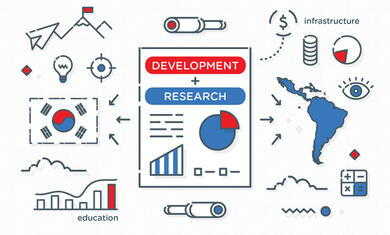
All-inclusive hotels: A key for Latin America and the Caribbean’s growth
The traditional all-inclusive concept has significantly evolved in recent years to better adapt to changing consumer preferences, demographics and booking patterns. Guest behavior and expectations are being reshaped by a shift in consumers’ mindset towards travel and the disruptive impact of technology. Travelers are increasingly seeking personalization and authenticity in their vacation experiences, more involvement and connection with the local community, and a genuine engagement in environmentally responsible practices—all of this while maintaining full control of their choices and increasingly relying on mobile and electronic devices as a preferred booking method. A revamped all-inclusive 2.0 model is becoming more sensitive to these consumer needs and undergoing an exciting metamorphosis.

Development Effectiveness: Adding Value beyond Financing
A new private sector In his recent annual letter to CEOs, Larry Fink, the founder and CEO of the investment firm BlackRock, called on companies to incorporate both profit and purpose into their business strategies. “Society is demanding that companies, both public and private, serve a social purpose. To prosper over time, every company must not only deliver financial performance, but also show how it makes a positive contribution to society.”

Empower women and investors will follow
Gender equality is no longer a choice for companies. It is not only about fairness, but about business success. For investors, this has become so clear that one of the world’s largest asset managers has just placed a statue of a defiant girl in front of Wall Street’s iconic bull in New York City to remind businesses that the time to fight for gender equality is now. Why? Because investors have realized that companies that foster diversity yield higher returns. More diversity improves decision-making, reputation, productivity, and employee retention and satisfaction, whTry ich in turn leads to higher returns. Companies with more diverse workforces are also better equipped to innovate in product development, tapping into new business opportunities, such as the women’s market. Investors are looking for results on gender equality But how can companies take concrete actions in line with what investors expect? The answer is not easy, as it requires looking at your company through a completely different lens. Statements and mere commitments to gender equality are not enough. In today’s data-driven world, investors are looking for information to evaluate companies’ performance and their environmental and social footprint. In the past few years, several gender equality indexes have emerged to help investors make informed decisions. Examples include the Barclays Women in Leadership Total Return Index, Pax Ellevate Global Women’s Leadership Index and the Bloomberg’s Financial Services Gender-Equality Index, among others. These benchmarks are tracking gender outcomes, including equal compensation and the number of women in leadership positions, employee policies, ability to create products and services for women, and community engagement. Some of these indexes have investment products to capture the benefits of gender diversity. Since 2014, both Barclays’ Women in Leadership Exchange Trade Notes and Pax Ellevate’s Global Women’s Index Fund enable investors to allocate capital in companies with strong female leadership. As investors’ appetite grow, similar initiatives are under way. Last year SSGA and California State Teachers Retirement System, the second-largest public pension fund in the US, launched the SPDR SSGA Gender Diversity Index ETF (SHE) to invest in companies with high levels of diversity on their boards. With over $280 million in assets, Berkshire Hathaway Inc and Oracle Corp. are among its top investors. A free tool to evaluate gender equality For those willing to roll up their sleeves and move beyond good intentions, the first step is knowing where you are and what you are doing. With this goal in mind, IDB Invest (formerly known as Inter-American Investment Corporation) and the Multilateral Investment Fund, along with UN Global Compact, UN Women and other public and private partners, have created a tool to help companies assess their gender equality performance. The tool follows the UN Women’s Empowerment Principles (WEPs) to unleash the potential of women in the workplace, marketplace and the community. The assessment is free and confidential and can be done by any company from any sector in any country. It looks at corporate policies in place and evaluates the extent to which firms provide equal opportunities, adequate work life balance, support to gender equality in the supply chain and respect to women’s rights in local communities. The tool has far-reaching potential for companies. Designed with the feedback of nearly 200 companies worldwide, the tool has proven to be eye opening for the firms that participated in the pilot phase. Some found that the assessment made them rethink their approach to gender equality in procurement and marketing, while others said it compelled senior management to improve processes. Others highlighted that the tool provided a road map to better integrate gender initiatives into the broader company’s strategy. So, if you are ready to face the bull and reap the benefits, complete the assessment and take action. Investors are waiting. This article was originally published on The Huffington Post Subscribe to receive more content like this! [mc4wp_form]

The First Commandment of Social Impact Generation
By Pablo Antón Díaz, Opportunities for the Majority The first commandment for companies and organizations that aim at generating social impact is adopting mechanisms to measure it. Every line is the perfect length if you don’t measure it, and this same rule applies to impact investing. Narratives on a handful of beneficiaries can be useful and serve as great instruments for attracting new investors, but the only sure way of knowing whether your efforts are indeed being relevant in the lives of people is through systematic measurement.

Can your trip to the beach help reduce poverty?
As summer comes to an end in the Northern Hemisphere, many of us have been asking and answering the same question: how was your vacation? Our responses typically include anecdotes about the food, people, and places we encountered along the way. Perhaps we could also be asking ourselves how our vacation impacted those people and places.

What can the private sector in Latin America and the Caribbean learn from Korea’s economic miracle?
They say that Korea achieved in three decades what it took the Western industrialized countries more than a century to do. But, how did it do that?